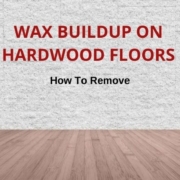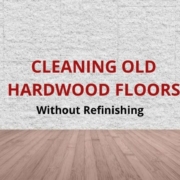How to Remove Mold on Hardwood Floors
For any homeowner, mold is one of the scariest household problems you can find. Unfortunately, it can grow easily with just a little moisture, organic material, and time. Hardwood flooring is one material that is prone to mold growth, especially in a bathroom or kitchen where water is present.
Mold can be extremely dangerous to people. For that reason, large mold problems require professional removal. If you discover mold that covers a large area or appears to be growing on studs, subfloor, or other structural elements of your home, call a professional.
If you just have a little mold on the surface, such as from a short-term leak or spill, you can go ahead and correct it yourself by following this guide. Protect yourself with the necessary gloves and a breathing mask.
After you remove the mold on your hardwood floors, you should always make sure to fix whatever allowed the mold to grow. Clean the area more often and fix any areas where water regularly leaks or pools.
Is Mold on Hardwood Floors Dangerous?
Not all types of mold are dangerous, but some definitely can be. Black mold can weaken neurological function and cause serious damage to the heart and lungs. Eventually, this can lead to death.
Mold can get into your lungs over time if you do not clean it up or quickly if you disturb the mold without a protective mask.
If conditions are wet enough, the mold can also eat into the walls and subfloor, weakening the structure of your house.
For these reasons, you need to protect yourself by cleaning bathrooms, kitchens, and other “wet” areas of your home regularly and checking plumbing occasionally for leaks or other mold-growing problems.
If you have discovered mold on your hardwood floors, make sure not to walk on or touch the mold in any way. This will disturb the mold and release it into the air.
Leave the moldy area alone until you are prepared with a certified mask (such as an N-95) or a filtered respirator. You should also wear disposable gloves when you remove the mold and throw the gloves away when you are done.
Signs of Mold Under a Hardwood Floor
If your wood floor has just a little mold growing on top, you can clean it and keep using it. But if the mold has penetrated deep into the flooring and subflooring, you have a much bigger problem on your hands.
First, inspect the wood for serious warping. If there are larger-than-usual gaps between planks or if the boards are curling up at the edges (cupping), you have significant water damage.
You can find out how deep the mold goes by checking to see if the wood is still solid. Take a flat screwdriver and try to press it into a board in the moldy area.
If you can’t press the screwdriver into the wood, it is probably still dry and clean below the surface. But if the wood is soft like a sponge and you can push the screwdriver deep into it, the wood is bad. Water and mold have penetrated deep into the floor.
If your floor fails the screwdriver test, you should call a flooring or cleanup professional to evaluate the leak and see how deep the moisture has spread.
Deep seeping moisture with mold will probably require that you completely replace the flooring in the area, and it may even be necessary to replace the subfloor materials.
How to Remove Mold on Hardwood Floors
Tools and Materials You Will Need
- Disposable rags, sponges, or paper towels
- Rubber gloves
- An N-95 mask or another filtering mask (not just a simple cloth or surgical mask)
- Water and a spray bottle
- Dish soap
- Bleach (optional)
- Vacuum cleaner with a HEPA filter (optional)
Step 1: Personal Mold Safety
At all times when cleaning mold, wear a filtering mask and gloves. Do not touch the mold or moldy materials with your skin. The spores may be too small for you to see and can make you sick or spread to other areas.
Throw away any gloves, paper towels, or rags that you use to touch the mold. Do not wash and reuse them. You should only need one or two rags to remove a small spot of mold.
Bring a garbage can near the spot you are cleaning so you do not have to carry your used rags through the house.
Ventilate the area without making it too windy. Open windows in the room and place a fan nearby — just don’t point the fan directly at the moldy area because it will blow mold spores around the room. When you are cleaning the mold, you can use the fan to blow the room out.
Always wash your hands with soap and hot water after working near mold.
Step 2: Use Soap and Water to Remove the Mold
Mix up a solution of dish soap and hot water. Rather than using a huge bucket that could spill on the hardwood floor, mix it in a spray bottle. This will work better for cleaning the mold anyway.
Dish soap will not kill the mold, but it is a good first step because it can remove most of the mold and cannot damage the finish on your hardwood floor.
Spray the dish soap solution on the moldy area until it is covered. Let it sit for 1 minute and wipe it off with a rag. Press down firmly and try to wipe up all of the mold in one swipe.
Dispose of the rag with mold on it immediately. Repeat if necessary.
Step 3: Kill Mold With Bleach (optional)
Bleach has a powerful sanitizing ability and can kill mold in just a few minutes. However, it has some dangers:
- Bleach puts off harsh fumes, so you need good ventilation in the room
- Bleach can only kill the mold on the surface of the wood, not what is growing below
- Bleach can damage the finish on your hardwood floor
Because of these risks, you might want to avoid using bleach on your floor. It depends on the finish you have on your floor and how deep the mold appears to be growing. You can test an inconspicuous spot to see if it hurts your floor’s finish.
If you decide to use bleach, water it down in a spray bottle. Use only 1 part bleach to 10 parts water (you can also use a bleach-based cleaner such as Clorox spray – just read the bottle to see if it is safe for hardwood floors).
Spray the bleach to completely cover the mold. It will start killing the mold on contact, so you do not need to let it sit for long.
Leave the bleach on the mold for no more than 5 minutes (you can wipe it off instantly if you are worried about your hardwood floor’s finish). Swipe it up with a rag and throw it away.
Note: You may have read that white vinegar can also kill mold. Some people prefer vinegar because it is natural — but vinegar is bad for hardwood floors. Vinegar takes 60 minutes to kill mold, which is way too long to leave liquid sitting on hardwood floors. It can damage the finish and seep into the wood, causing bigger problems. Skip the vinegar for your hardwood floor and use a bleach solution that kills mold faster.
Step 4: Clean Up
Dry any spills you may have made while cleaning. Throw away any rags or paper towels that touched the mold. Take out the trash.
If you have a vacuum cleaner that is equipped with a HEPA filter, you can vacuum the room to remove any mold spores.
A regular vacuum filter will not catch the spores but rather spread them around the room. So, if you don’t have a HEPA vacuum, just mop the floor with a mild cleaning solution.
Throw away the gloves and mask you wore while cleaning and wash your hands thoroughly with soap.
Preventing Mold on Hardwood Floors
The two best ways to prevent mold are to clean regularly and to keep moisture from getting to the wood in your house.
Wood floors should be mopped with a light cleaning solution designed for hardwood. This can help to remove the first mold cells before they grow and eat into the hardwood floor.
Make sure to wring the mop out so you do not put too much water on the wood. It’s a good idea to dry the floor with a microfiber mop afterward.
Mopping every few weeks will go a long way to prevent mold growth.
There are several things you can do to keep moisture low on your hardwood floors:
- Always dry up spills or excess mop water right away
- Inspect plumbing occasionally and fix any leaks
- Also inspect windows and doors and repair leaky seals
- Control splashing in common areas with rugs, a shower curtain, etc.
- Seal crawl spaces and sump pump basins that can humidify your house
Any large amount of water can cause mold. Even small amounts of moisture can let mold grow if the area is frequently wet. You can buy a wood moisture sensor if you are concerned about humidity affecting the wood in your house. This machine will give you a percentage of moisture content for the wood to show whether you are in danger of growing mold.
* Last updated on 2024-07-27 / We are using affiliate links / All images are served from the Amazon Product Advertising API.
Table of Contents







